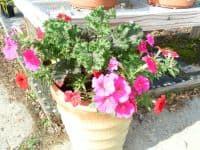
Autumn Flowers
Continue to plant cool season flowers this month such as petunias, chrysanthemums, pansies, viola, dianthus, snapdragon, alyssum, sweet peas, calendulas, forget-me-not, lobelia, cyclamen, primrose, nicotiana, ornamental cabbage & kale.
Begin to plant spring flowering bulbs this time of year. Bulbs such as narcissus, Dutch iris, daffodils, Spanish bluebells, snowflakes, alliums, fressia, anemone and ranunculus should be planted by early December.
(Photo, above: Lavender Foxglove in bloom last Spring with pink foxglove pre-bloom [left], chrysanthemum in foreground & blue Iris in background)
Foxglove for Spring Flower 2014
Digitalis purpurea commonly known as foxglove is best when planted now. The Camelot foxglove, a former LSU AgCenter Louisiana Super Plant, is seed-propagated. Flower colors are white, cream, lavender and rose. For best landscape results buy & plant container grown foxglove in November for spring flowers. You can also wait to plant until late January through mid-March but I find that the flowers are not as sturdy as when planted in fall. Plant foxglove in well drained soils. They perform well in full sun to partial sun/partial shade. If you have not used or grown these great plants before, be thinking about adding them this fall.

Camellias
Camellia sasanqua is an evergreen shrub with Autumn & winter blooms in red, pink, white & various shades in between. Blooms may be single, half-double or peony form. November to March is the best time to plant. Camellias perform best when planted in acid soil in slightly shady areas as foliage and blooms may burn in full sun. Plant in a hole twice as wide and slightly deeper than the root ball. Just before new growth in late winter, fertilize with azalea/camellia food. Use according to label rates. Fertilize at half rate in Autumn to prepare for blooming. Camellias like moist soil & thick mulch. Prune in spring and deadhead flowers regularly. Camellia sasanqua may be used for screening, espalier or in tree form. Scale insect is a problem and may require spraying, C. sinensis or tea plant does well in our area and produces creamy-white flowers in late autumn. It is the same tea plant that has been cultivated for tea in China for centuries.

Pests on Houseplants
Indoor outbreaks of insect pests can spread rapidly and cause tremendous damage. The rapid spreading occurs because we often group houseplants together in well-lit locations close to windows or glass doors and also because we handle healthy plants after handling infested plants. Three of the most common insect pests found indoors are mealybugs, scales and spider mites. Close and regular inspection of your plants indoors is the best defense against insect outbreaks. Mealybugs are small, oval, softbodied insects that usually are less than one-eighth inch long, distinctly segmented and covered with white powdery or cottony waxy secretions. They are sucking insects that feed on the plant’s sap and don’t move around much on the plants. They typically occur in groups or clumps. Look for white cottony masses in the growing points of plants, in their crowns, under their leaves and where the leaves join the stem of the plant. Scales are related to mealybugs and also are sucking insects. They are covered with a dome-shaped waxy coating that is most often white, tan or brown, depending on the type of scale. Once they are large enough to notice, they are stationary. Their immobility and waxy covering make them difficult to notice, and once you do see the strange bumps or dots on the plant, you would never think that they are insects. Mealybug or scale-infested plants often will have shiny, sticky leaves. Even the floor or table the plant sits on may become sticky. This is the result of the accumulation of honeydew, a sweet, sticky excretion of the insects, on surfaces under the plant. Spider mites are very tiny, and the damage they cause is initially very subtle. Early damage causes the foliage to appear dull, faded and unhealthy. As damage increases, new growth may be stunted, and deformed and older leaves may become very faded, show signs of browning and begin to drop off. High populations of mites may produce fine webbing between leaves and where the leaves join the main stem.

When you detect a pest problem, take prompt action. First, isolate the infested plant or plants. All three of these pests are contagious. Always wash your hands after working with an infested plant, especially if you are about to handle healthy plants. Spraying the plant every day with a strong stream of water (especially under the leaves) usually will get rid of spider mites. Continue spraying for at least a week. Indoors, spraying will work well only for plants small enough to move to sinks or showers. Otherwise, move plants outside to a shady area for treatment (weather permitting). A strong stream of water can be tried on mealybugs, but you should also scrub at the cottony clusters with a soft toothbrush to dislodge them. If you decide to use pesticides, you must choose materials that are safe to use on the plant you intend to spray and labeled for use on plants indoors. Mealybugs, scales and mites all can be controlled by horticultural oil sprays, which kill these pests by suffocation and are relatively low in toxicity. Many insecticidal soap products also have labels for indoor use and are excellent for mites and good on mealybugs but not very effective on adult scale. And the pre-mixed houseplant insecticides that contain pyrethrum or pyrethrin as their active ingredient are effective on these pests. Always use pesticides cautiously, and follow label directions precisely. Be prepared to make several applications for complete control. Since spraying can be messy, particularly when spraying larger plants, move plants outside to spray them whenever practical.

Vegetables & Herbs to plant in November…
Beets, cabbage, celery, collards, rutabaga, leeks, shallots, garlic, Swiss chard, spinach, kale, radishes, mustard, carrots and turnips, borage ,chervil, cilantro/coriander, dill, fennel, parsley, bee balm, burnet, catnip, chives, garlic chives, horseradish, lemon balm, mints, oregano, pennyroyal, rosemary, sage, marjoram, thyme, winter savory, French tarragon, feverfew, lavender and chamomile.
Autumn Care for Lawns
Brown patch disease can come and go throughout the winter if the weather is mild. Treatment with fungicides containing myclobutanil, propiconazole, pyraclostrobin, thiophanate-methyl and triticonazole will reduce the spread of brown patch. In addition, azoxystrobin is now available as granular fungicide. Azoxystrobin is one of the best fungicides on brown patch disease. Damage from brown patch will slow spring green-up, and affected areas will remain unsightly until warmer spring weather conditions allow for turfgrass recovery.
submitted by Karen Blackburn
